Kiyomizudera is a famous temple and UNESCO world heritage site in Kyoto. Its name comes from the waterfall in the complex and literally it translates as clear water (Kiyo Mizu) temple (dera). In this fourth post in our Walking Kyoto series, we head 1.7km north east of Sanjusangendo to explore Kiyomizudera and the area surrounding it.
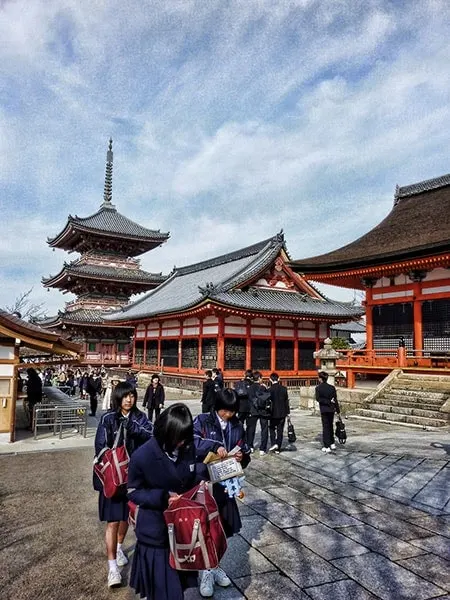
Kiyomizudera was founded in 798 and the present buildings date back to 1633. We’ve visited the temple several times in both winter and spring time and always enjoy it. The cherry blossom are stunning here if you time it right and always brings out the young women in their colourful summer yukata although they must be freezing in the light fabric. I’ve heard great reports of the autumn colours too so will definitely go back some time for koyo.
Table of Contents
Inside the Kiyomizudera temple complex
Here I’ll just show you a few glimpses of the temple grounds, it’s a large complex and there is so much to see. When you arrive at the temple climb the stairs and pass through the Nio-mon gate then find a spot to look back the way you came for great views over Kyoto city if it’s a clear day.
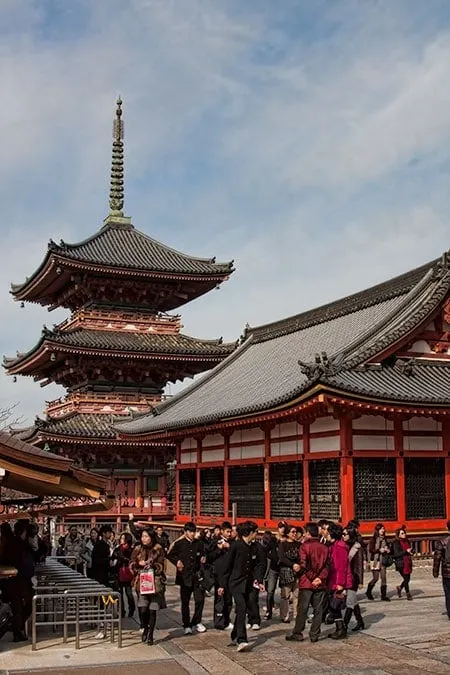
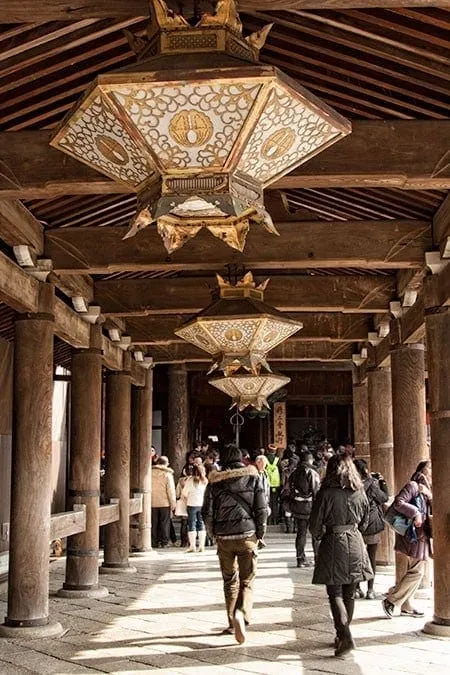
The temple buildings at Kiyomizudera are in a number of different styles, I love the look of the vermillion orange against a blue sky but the huge main hall with its thatched roof and overhanging verandah held in place without a single nail that steals the show.
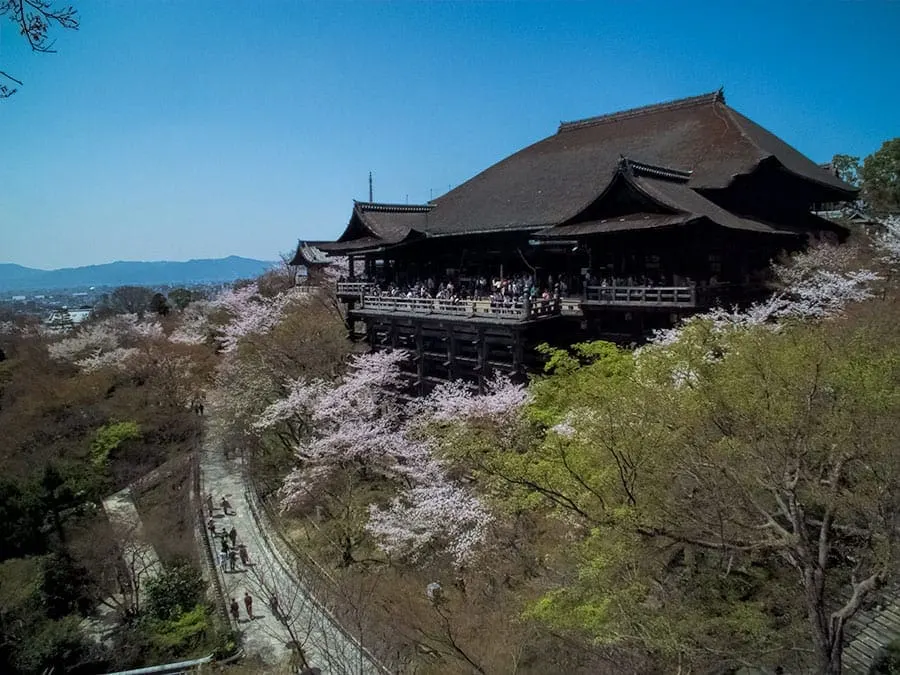
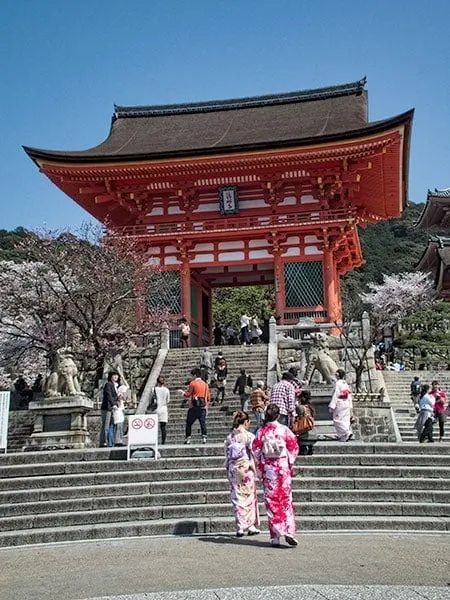
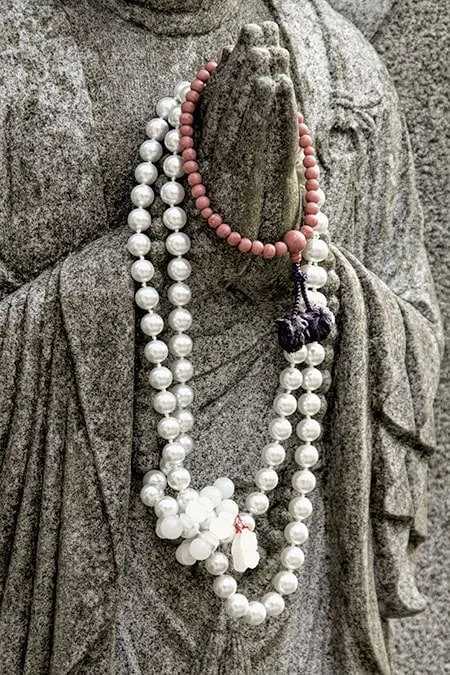
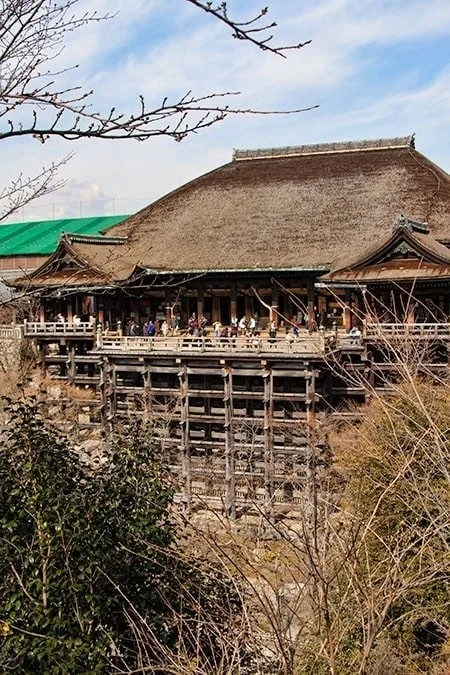
The Otowa-no-taki waterfall
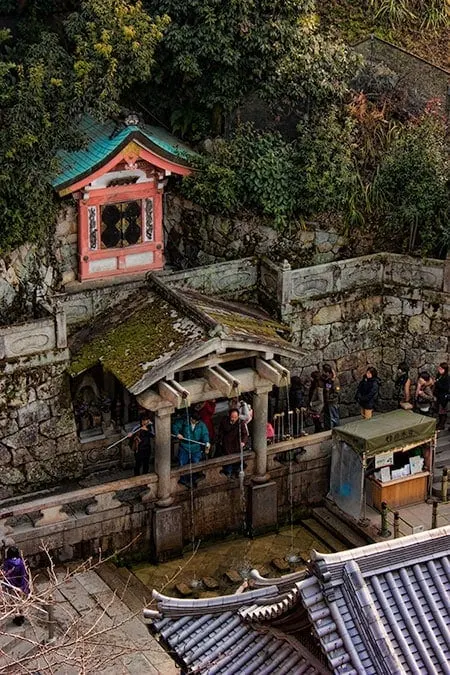
The waterfall, Otowa-no-taki, has three streams of water that are said to possess the power to grant wishes. Although some say each stream possesses a different power of longevity, love and knowledge the locals will tell you that each is the same strong blessing.
What is agreed is that you should drink from only one, if you drink from two the blessing is halved and to drink from all three is greed and will not be rewarded.
The process to drink from the waterfall is to take your ladle in your right hand and hold it under the water to fill it.
Swap the ladle to your left hand and pour a little water into your hands to rinse them, then pour into your right hand and drink from your hand, not the ladle. You may also want to offer a prayer while you drink the water.
At the source of the waterfall is where the blue dragon is said to live, several times a year the dragon appears in a festival called Seiryu-e which is definitely worth a trip to Kiyomizudera if you are in Kyoto.
Jishu Shrine
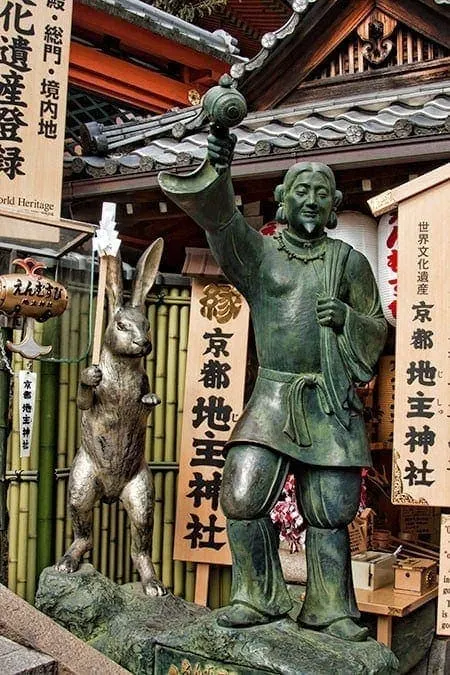
Shinto and Buddhism mingle together at Kiyomizudera with the Jishu Shrine located deep within the temple grounds. As you exit the main hall before walking down to the waterfall the entrance to the shrine is on your left. It’s easy to miss but well worth a stop.
In this photo you can see Okuninushino-mikoto the deity of love and good matches and the rabbit next to him is his messenger. Not surprisingly this shrine is packed with teenagers in their school uniform in search of true love.
The only other shrine we’ve seen quite so popular with the school crowd was the Yushima Tenjin shrine in Tokyo on exam week.
Probably the most popular attraction at the shrine is the love stones and it can get quite loud and crowded around them.
The love stones are placed 18 metres apart and it’s said that if you can make your way from one rock to the other with your eyes closed you’ll be lucky in finding love. It’s not cheating to have someone helping you by calling directions or pushing you back on course but if you find your way to the second rock with someone guiding you, then it is said you will need a matchmaker to find your soul mate. It was fun to watch for a while and judging by the level of help some needed to find the second stone the art of matchmaking has a long future in Japan.
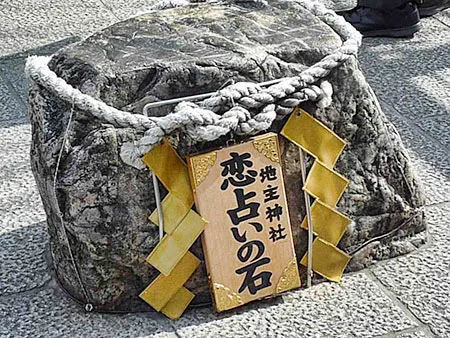
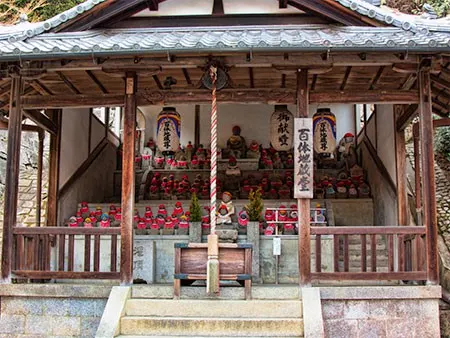
Kiyomizudera Shopping Street
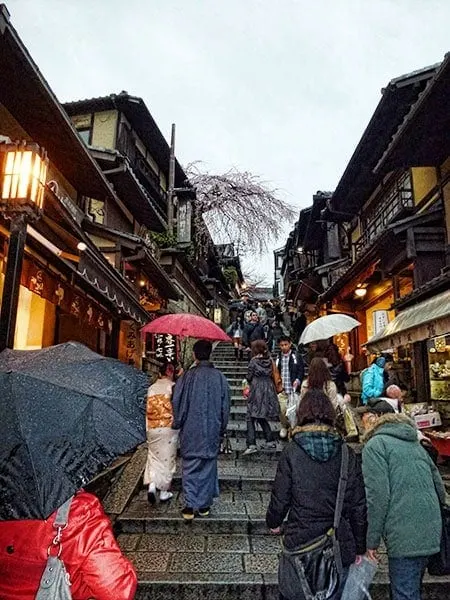
There are a couple of streets leading up to Kiyomizudera temple that is worth exploring on your way there or back. They are historical streets with paved lanes and old wooden merchant houses. These lanes are filled with small shops selling souvenirs, Kyoto handicrafts and food items.
The lane that runs directly down from the temple is Chawan-zaka or ‘teapot lane’ which is memorable for me because I saw the most gorgeous teacups down here on one of our visits.
I should have bought them at the time but didn’t because I didn’t want to carry them with me for the rest of the day. I learned my lesson that day because I couldn’t find them or any others I liked nearly as much anywhere else and I have returned to look every time have visited the city since.
Some of the snack foods up here are worth the walk up just to try them. One of my favourites that we have been back to on consecutive trips is the shop that sells shu creams which are choux pastry with flavoured pastry cream, it sounds simple but it’s really good especially in spring for the sakura custard one, it’s so good. Another a little further out as you head down into Higashiyama sells piping hot dumplings from a tiny counter that are among the best I’ve tasted anywhere. Just the thing to warm up the fingers and the tummy on a cool day.
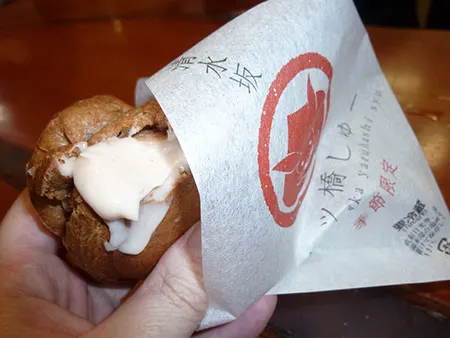
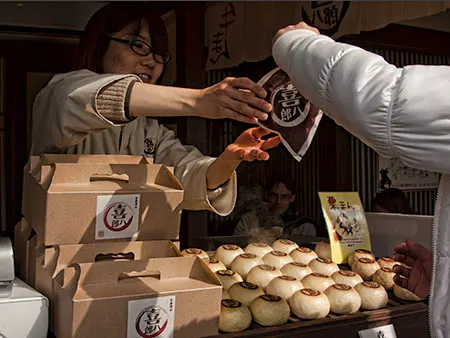
Getting to Kiyomizudera temple and general information
If you are continuing on with the eastern Kyoto self-guided walk from our previous stop at Sanjusangendo then the walk to Kiyomizudera is 1.7km and will take around 20 minutes. Alternatively, you can take bus 100 or 206 from Kyoto Station, it will cost Y230 and around 15 minutes.
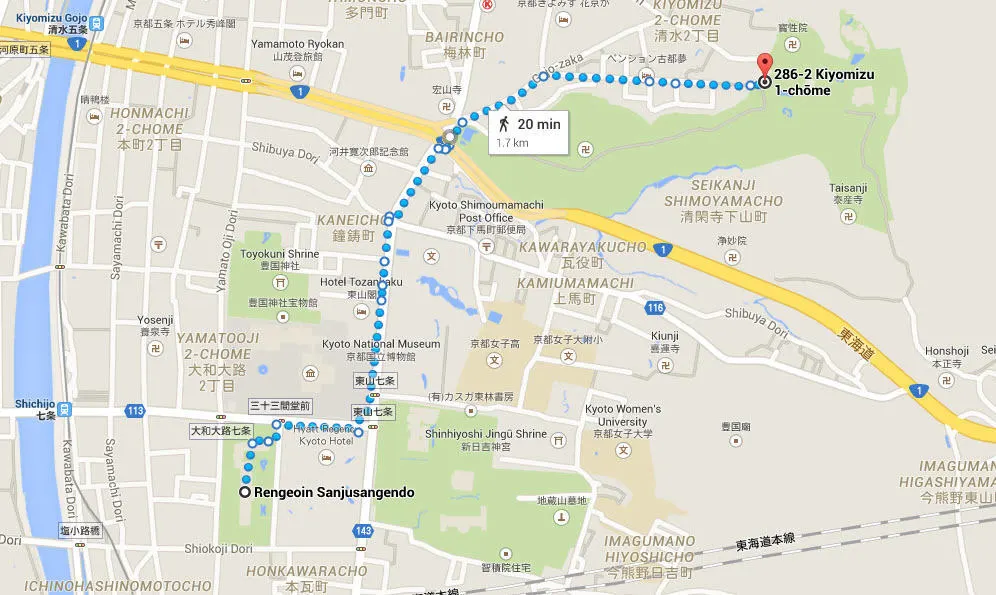
Facilities, Fees and Finer details
Like many temples in Japan you pay a fee only to enter the inner temple, not the temple grounds but having made your way up here you wouldn’t want to miss standing on the large veranda of the main hall that has stood for centuries without a single nail or seeing inside the main hall. Entry is Y300 from 6 am to 6 pm.
The temple has several special opening events during the year and a fee of Y400 applies during the evening for the spring (sakura) and Autumn (koyo) light-up events.
Sofia
Friday 3rd of January 2020
Hello, I'm so glad I found your story from pinterest ? It's so easy to imagine and I already write down on my checklist
Plan to go there on 18th january ..
Thanks you! Please keep writing ??
Cheers, Sofia
Toni Broome
Sunday 5th of January 2020
Enjoy! It's a beautiful city.
Bradley
Sunday 4th of January 2015
I love your Walking Kyoto series! Sanjusangendo is one of my favourite spots in Kyoto. This past week, I visited Kiyomizudera and went into the Tainai Meguri. It's off to the left of the main gate, and costs ¥100 to enter. Down steps into pitch black, with only a railing of large Buddhist beads at your left hand to guide you. You come around the corner to see a large stone with a Sanskrit character on top. You make a wish at the stone, then travel again through darkness until you reemerge like a newborn. Fascinating!!
twoaussietravellers@yahoo.com
Sunday 4th of January 2015
Thanks for the tip on Tainai Meguri, we've been several times to Kiyomizudera but somehow missed this totally. It's now on my list for our next trip to Kyoto.